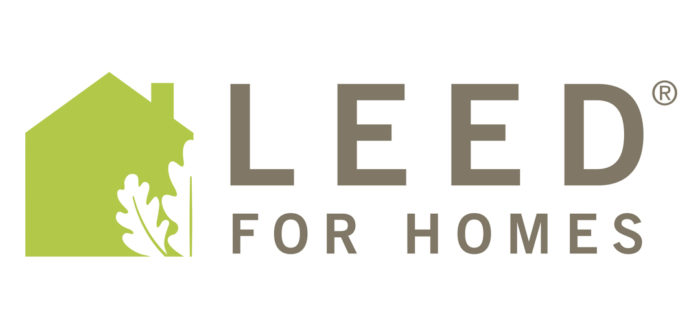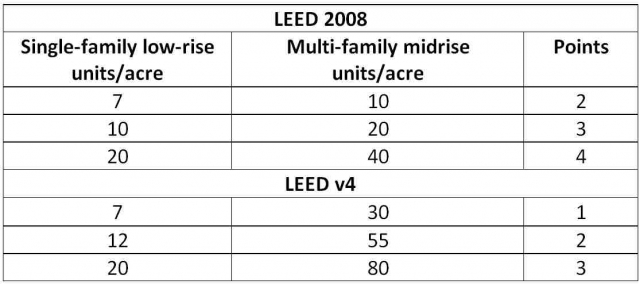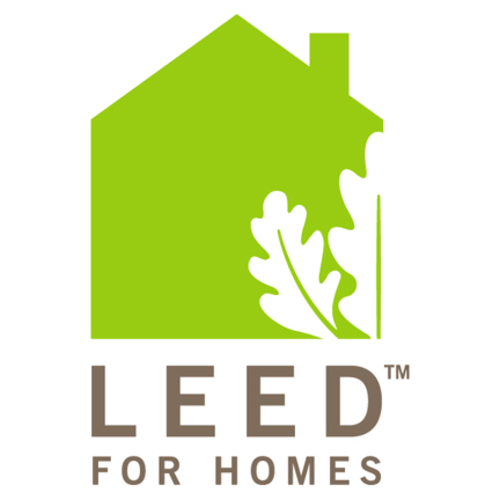
Image Credit: USGBC
In this concluding part of my two-part blog series on the soon-to-be-released LEED for Homes version 4, I follow up my introduction to the topic (Part 1), in which I covered some major structural makeovers from LEED for Homes 2008. In that blog, I also discussed changes in just two categories: Water Efficiency (WE) and Indoor Environmental Quality (EQ). On balance, I found those two categories to be most improved … not that I didn’t have some critiques!
Today’s topics are the reincarnations of the remaining categories: Innovation & Design Process (ID), Location &Linkages (LL), Sustainable Sites (SS), Energy & Atmosphere (EA), and Materials & Resources (MR). Awareness & Education (AE) has been subsumed within EA. We have a new category to review, too: Regional Priority (RP). Rather than picking favorites (or un-favorites), I’ll just take it from the top.
Innovation & Design Process (ID) … or rather, Integrative Process (IP) and Innovation (IN)
Yes, it’s true. The slim but mighty Innovation & Design Process category has split up like a divorced family, with some members migrating to the new Integrative Process category and others to the new Innovation category. Why, is a mystery perhaps best left un-plumbed.
There are some noteworthy substantive changes, among the two new family branches.
The “LEED AP” credit (INc2) is now less restrictive, simply requiring that one principal team member be an “appropriate” LEED AP. (But I often find inappropriate people so much more interesting – don’t you?!) Seriously, though, this is a bad idea. The whole point of limiting this credit to the LEED AP+ Homes was to encourage the team to include someone who had a clue about the important ways that LEED for Homes differs from the rest of the LEED family, and so wouldn’t steer the team astray with ill-informed notions about how the rating system works.
If I had a nickel (OK, ten bucks) for every LEED AP who thought s/he knew enough to guide a LEED for Homes project – and most emphatically did NOT – I would be several thousand dollars wealthier. And I’m only talking about those I’ve personally encountered!
The actual “innovation” credit (INc1) is pretty much the tried-and-true, but adds a new option, the ability to use a credit from the LEED Pilot Credit Library. Woohoo.
The best change here is the adoption of the Trades Training credit, formerly restricted to Mid-rise, now available to all Homes projects (IPc1). Very sensible, though far from bulletproof. (A story for another blog …)
The heart and soul of the category-formerly-known-as-ID was the Durability Management credit. It hasn’t departed the rating system, but it has decamped to Materials & Resources. We certainly considered planting it there in the first place, but ultimately decided that because it embodied a process that had to be addressed from the earliest stages of design, it belonged up front (as did the whole category, for that matter … where we put it!) with other aspects of the design process, as suggested by the (former) category name. Had anyone asked, I would have argued strenuously to keep it in the Integrative Process category, which – as it should be – still resides at the top of the rating system.
Location & Transportation (LT), formerly Location & Linkages (LL)
Mostly I’m unflapped by the changes in this category – and the changes are numerous. I’ll start, though, by airing one of my BIG BEEFS. It has been a BIG BEEF for quite some time, but v4 has now made it a BIGGER BEEF.
The LEED for Homes Committee felt quite strongly that there was one measuring stick for the planet, and that meant there should be only one measuring stick for residential development projects. In other words, dense, urban, affordable housing should be judged on the same basis as sprawly suburban housing. This had a lot to do with the genesis of the threshold adjustment (which meant a larger home had to compensate for its greater energy and materials use by earning more points to achieve the same LEED rating as its more modestly sized counterpart).
It was also intended to ensure equity with respect to density. Things went off the rails, unfortunately, when the Mid-rise rating system was launched. Exactly counter to the drafting committee’s intentions, two separate measuring sticks (point scales) were created – one for single-family low-rise homes and another for multifamily mid-rise homes. Mid-rise projects had to achieve much higher levels of density to earn the same credit as low-rise projects. [Gnashing of teeth.]
Now in v4, this wrong-headed thinking has been expanded, with even greater inequity between low-rise and mid-rise projects.
I get it that if you’re building mid-rise housing, we want to encourage it to be more rather than less dense! But in what universe does it make sense to reward low-density projects at all, if what we’re trying to encourage is higher density?! Not only that, but we haven’t even ratcheted up the performance expectations for single-family homes. Why NOT? Whatever happened to the notions of equity and continuous improvement?
That’s probably a long enough rant for this category, but … I forgot to mention that this credit used to reside in Sustainable Sites (SS6); it’s now LTc3. It should have stayed in SS, because it’s not a decision about where you build, but how you utilize the site. Admittedly, that’s the least of my concerns here.
Other changes to LT include a wider assortment of ways to earn credit (and more points – up to 8) for site selection (LTc2), including a good street network, bike network, and bike storage, all of which is good with the possible exception of giving bike storage credit to single-family homes with private garages. [Really?! Good on ya for having a garage!!?]
Access to transit now has its own credit (LTc5), separate from community resources (LTc4). No complaints here, though LTc5 looks a wee bit complicated.
And there’s a new prerequisite: LTp1, floodplain avoidance. Avoiding building on a floodplain used to help you earn credit, now it’s simply a no-no (though previously developed buildings and hardscapes are exempt). Good. This seems like a no-brainer for a project that’s supposedly demonstrating leadership.
Sustainable Sites (SS)
The changes to Sustainable Sites are mostly rather plain-Jane updates. The highlights here are another migration from Midrise – a cool roof can now earn credit in any Homes project (SSc1, was SS3).
The rainwater management credit (SSc2, was SS4) is now more complicated and involves different compliance approaches and reference standards, varied by building type.
Nontoxic pest control (SSc3, was SS5) has experienced some point shuffling, addition of new measures, and a new requirement for multifamily projects to develop an integrated pest management (IPM) policy for inclusion in the homeowner manual.
Energy & Atmosphere (EA)
To make up for my brevity in describing SS, I’ve got a lengthy dissertation about Energy and Atmosphere. For starters – and this is not a substantive complaint but rather an informational one – none of the LEED v4 documents that I’ve been consulting has been clear about the changes, if any, to the prescriptive vs. performance path through the EA credits. USGBC’s Asa Foss reports that, “These pathways do still exist. The pdf of the rating system has both paths spelled out. [N.B. Not really!] However, we are working on graphics for both the rating system pdf and the credit library to better clarify the options.” In the absence of this guidance, what follows may not be totally accurate! Do not hold me responsible.
Aside from the major reconfiguration of the threshold adjustment (size) mechanism – about which I’ve probably already complained sufficiently – the other most significant change to the EA category is the shift to Energy Star for Homes version 3 as the reference standard (EAp1, EAc1). With this shift comes much greater rigor – in both the performance pathway and in the corresponding credits in the prescriptive pathway (as I understand them) – and the absorption into Energy Star of several performance testing items that previously existed as LEED for Homes credits. They no longer show up directly here, but are instead “hidden” in the Energy Star prerequisite (EAp1).
While I’ve always supported Energy Star as a foundation for the EA category, I foresee further challenges on the horizon with yet more mandatory compliance activities having been made invisible in this way. Having worked with project teams since the beginning of the LEED for Homes Pilot, I’m acutely aware that these hidden requirements often cause ripples in otherwise smooth waters. Notwithstanding frequent and stern admonishments to team members regarding such crucial requirements as the Thermal Bypass Inspection, duct testing, etc., they are all too often neglected, with unpleasant – and occasionally irreparable – repercussions.
The minimum performance bar for midrise projects is now 5% above ASHRAE 90.1-2010, as compared to 15% over ASHRAE 90.1-2007.
Points for annual energy use reductions greater than the required minimum now can be calculated by one of two methods – using the “LEED Energy Budget” or the HERS Index. Here it gets too involved for me to comment as to whether this is better, worse, harder, easier … or just more complicated. I look forward to comments from those who have greater insight into the new approach. I also look forward (if that’s the right expression) to seeing how this manifests in the California rendition, yet to be unveiled! (For those of you unaware of this, we’ve always had a California-specific version of the EA section, which references our Title 24, Part 6, energy efficiency standards, so that our builders don’t have to use multiple simulation models.)
Energy metering and monitoring are welcome new introductions, in EAp2 (energy metering) and EAc5 (advanced utility tracking, up to 2 points). Disregarding the few exceptions, every building must have a gas meter and every dwelling unit must have an electric meter. Occupants are “encouraged” to share their usage data with the USGBC. Points are available for energy monitoring, irrigation system sub-metering, and/or third-party utility reporting.
Other new credits reward solar-ready design and HVAC commissioning, performed in compliance with the Energy Star v3 protocol, by a NATE-certified contractor or equivalent (several alternative qualifications are offered).
Water heating distribution now has only two pathways, but a new option for performance testing based on water volume; and there are new requirements for protecting buried piping. The efficiency thresholds for water heating equipment have been streamlined, eliminating differences between gas and electric systems.
Space heating and cooling system credits (EAc10 and EAc11) have changed somewhat, with points for heating and cooling equipment awarded separately, new provisions for ductwork in conditioned space, and different allowable duct leakage rates for large vs. small homes or multifamily units.
Major lighting improvements – hurray! Indoor lighting credits are now based on lighting power density, and outdoor lighting must comply with Dark Sky standards. Midrise indoor lighting points now based on reductions from the Energy Star multifamily midrise baseline.
The appliance credit (was EA9, now EAc14) has changed little, save the move of clothes washers to WE.
Renewable energy points are now much simpler to determine: 1 point for each 500 kWh/yr produced. However, the simplicity ends there, devolving rapidly into nonsense. After clearly showing “1-4 points” under the credit title, the requirements state, confusingly, “The maximum allowable points for this credit is [sic] equivalent to the total points earned from all other EA credits.” That statement would suggest a much larger possible score. As if that weren’t puzzling enough, the final sentence reads, “Renewable energy certificates (RECs) must be retained by the building owner.” Hm … first mention of RECs; are they allowed? If so, under what circumstances? More, no doubt, will be revealed.
And so endeth the EA chapter.
Materials & Resources (MR)
Ah, Materials & Resources, how do I love (and hate) thee?? Let me count the ways …
Of all the hours I’ve toiled over LEED as a whole during the past 15-or-so years, a staggering preponderance have been invested in this gnarly, intractable category, this Pandora’s Box of the green building realm … the place where one attempts to weigh the relative value and impact of apples, oranges, stepladders, and wingnuts.
So if LEED for Homes is my baby, then MR is my baby’s baby, and its eternal fan and critic am I both. This time, mostly critic, not so much fan.
There aren’t too many credits, so I can diss them all in roughly equal measure.
MRp1, certified tropical wood: the notification requirements have been removed. What were they thinking? The notice to wood vendors of the FSC tropical wood requirements was put there because we learned during the pilot that project teams had ended up with non-FSC tropical wood in their projects against their wishes! Quelle horreur! So the fix was to say that if adequate notification had been given, teams could not be punished (i.e., precluded from achieving LEED certification) because of a vendor’s error. This isn’t hard to do; it’s a very simple awareness measure and a safeguard of the builder’s interest. PUT IT BACK. >:
Regional Priority (RP)
There’s just one lone RP credit, worth up to 4 points – 1 point each associated with up to four credits chosen from the LEED RP database, which presently comprises just six credits: On-site renewable energy; Daylight & views – daylight; Alternative transportation – public transportation access; Heat island effect – non-roof; Innovative wastewater technologies; and Water use reduction. According to “Ask Jeremy” on the USGBC website, “They are not new credits, but instead are existing LEED credits that are prioritized in a given area and earn an additional point if the prioritized credit itself is earned.” To find out what earns credit in your area, enter your zip code in the filter at http://www.usgbc.org/rpc. This doesn’t appear to have been well thought out, given the listed credits are not Homes credits … so how would they be earned?
Summing Up
What I’d really like is to be able to pick and choose among the v4 changes, and implement only those that I felt were bona fide improvements. But since that’s not an option, I’ll probably just stall – and encourage my clients to do likewise – on adoption of v4 for as long as possible.
In the meantime, it seems we’ll be offered an intermediate option; an update of LEED 2008 is on the horizon, offering far fewer changes than v4. I haven’t thoroughly vetted it yet, but hope to find it more appealing than v4.
[Ann Edminster
is the owner of Design AVEnues
, a green building consulting firm in the San Francisco Bay Area. She is also a member of GreenBuildingAdvisor.com’s team of advisors
and is the former chair and co-chair of the LEED for Homes Committee.
Weekly Newsletter
Get building science and energy efficiency advice, plus special offers, in your inbox.
















One Comment
Insane
Instead of creating and reworking LEED, just publish fully designed projects that are what the LEED almighty desire of all the lesser.
This million page point system in my little mind is nonsense.
On a positive note, it helps me know what not to waste my time on.
Anyone who still wants a trophy, just email me and I'll get a nice one right out to you with a framed green certificate for the sales room.
Aj (positively not a LEED, more a modern day luddite)
LUDDITE trophy packages starting at $19.95 free shipping
To qualify one must not count points and must recycle all LEED materials into the nearest woodstove
Log in or create an account to post a comment.
Sign up Log in